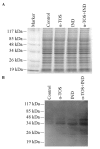Effect of α-tocopheryl succinate on the molecular damage induced by indomethacin in C6 glioma cells
- PMID: 25574239
- PMCID: PMC4280948
- DOI: 10.3892/etm.2014.2101
Effect of α-tocopheryl succinate on the molecular damage induced by indomethacin in C6 glioma cells
Abstract
Indomethacin is a member of the non-steroidal anti-inflammatory drug (NSAID) class, which has great potential for use in the treatment of glioma. However, it induces the generation of reactive oxygen species (ROS) and causes molecular damage while inducing its effects. Vitamin E is widely used in the complementary therapy of cancers. The main goal of the present study was to investigate the effects of α-tocopheryl succinate (α-TOS) against the oxidative damage induced by indomethacin in C6 glioma cells. Cells were treated with 10 μM α-TOS alone or in combination with 200 μM indomethacin for two days. The intracellular ROS level, molecular damage as revealed by lipid peroxidation and protein carbonyl formation, and the COX activity in C6 glioma cells were measured. Treatment of the cells with α-TOS and indomethacin, alone or in combination, caused the levels of ROS generation and protein damage to increase, but protected against lipid peroxidation and reduced COX activity.
Keywords: C6 Glioma; indomethacin; intracellular ROS level; protein carbonyls; α-tocopheryl succinate.
Figures



Similar articles
-
Role of reactive oxygen species in the induction of apoptosis by alpha-tocopheryl succinate.Int J Cancer. 2004 Nov 10;112(3):385-92. doi: 10.1002/ijc.20424. Int J Cancer. 2004. PMID: 15382062
-
α-Tocopheryl succinate-suppressed development of cerebral malaria in mice.Parasitol Res. 2018 Oct;117(10):3177-3182. doi: 10.1007/s00436-018-6016-2. Epub 2018 Jul 20. Parasitol Res. 2018. PMID: 30030625
-
Crosstalk between endoplasmic reticulum stress and oxidative stress in apoptosis induced by α-tocopheryl succinate in human gastric carcinoma cells.Br J Nutr. 2013 Feb 28;109(4):727-35. doi: 10.1017/S0007114512001882. Epub 2012 Jun 7. Br J Nutr. 2013. PMID: 22676837
-
The role of alpha tocopheryl succinate (α-TOS) as a potential anticancer agent.Nutr Cancer. 2014;66(2):167-76. doi: 10.1080/01635581.2014.863367. Epub 2013 Dec 23. Nutr Cancer. 2014. PMID: 24364743 Review.
-
Alpha-tocopheryl succinate epitomizes a compound with a shift in biological activity due to pro-vitamin-to-vitamin conversion.Biochem Biophys Res Commun. 2002 May 24;293(5):1309-13. doi: 10.1016/S0006-291X(02)00358-3. Biochem Biophys Res Commun. 2002. PMID: 12054655 Review.
Cited by
-
Nanoemulsion Composed of α-Tocopherol Succinate and Dequalinium Shows Mitochondria-Targeting and Anticancer Effects.Antioxidants (Basel). 2023 Feb 10;12(2):437. doi: 10.3390/antiox12020437. Antioxidants (Basel). 2023. PMID: 36829996 Free PMC article.
References
-
- Lamson DW, Brignall MS. Antioxidants and cancer therapy II: quick reference guide. Altern Med Rev. 2000;5:152–163. - PubMed
LinkOut - more resources
Full Text Sources
Other Literature Sources
